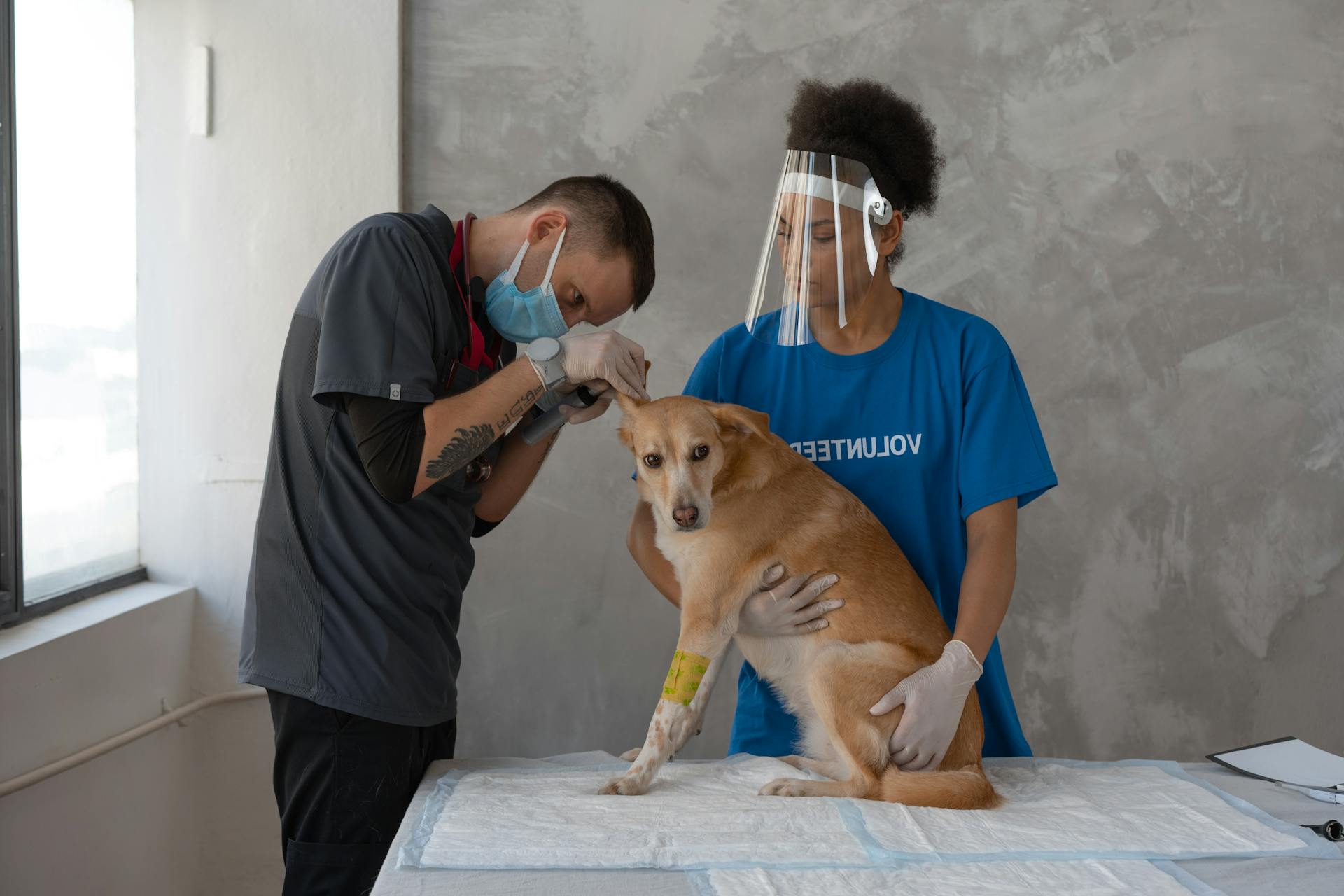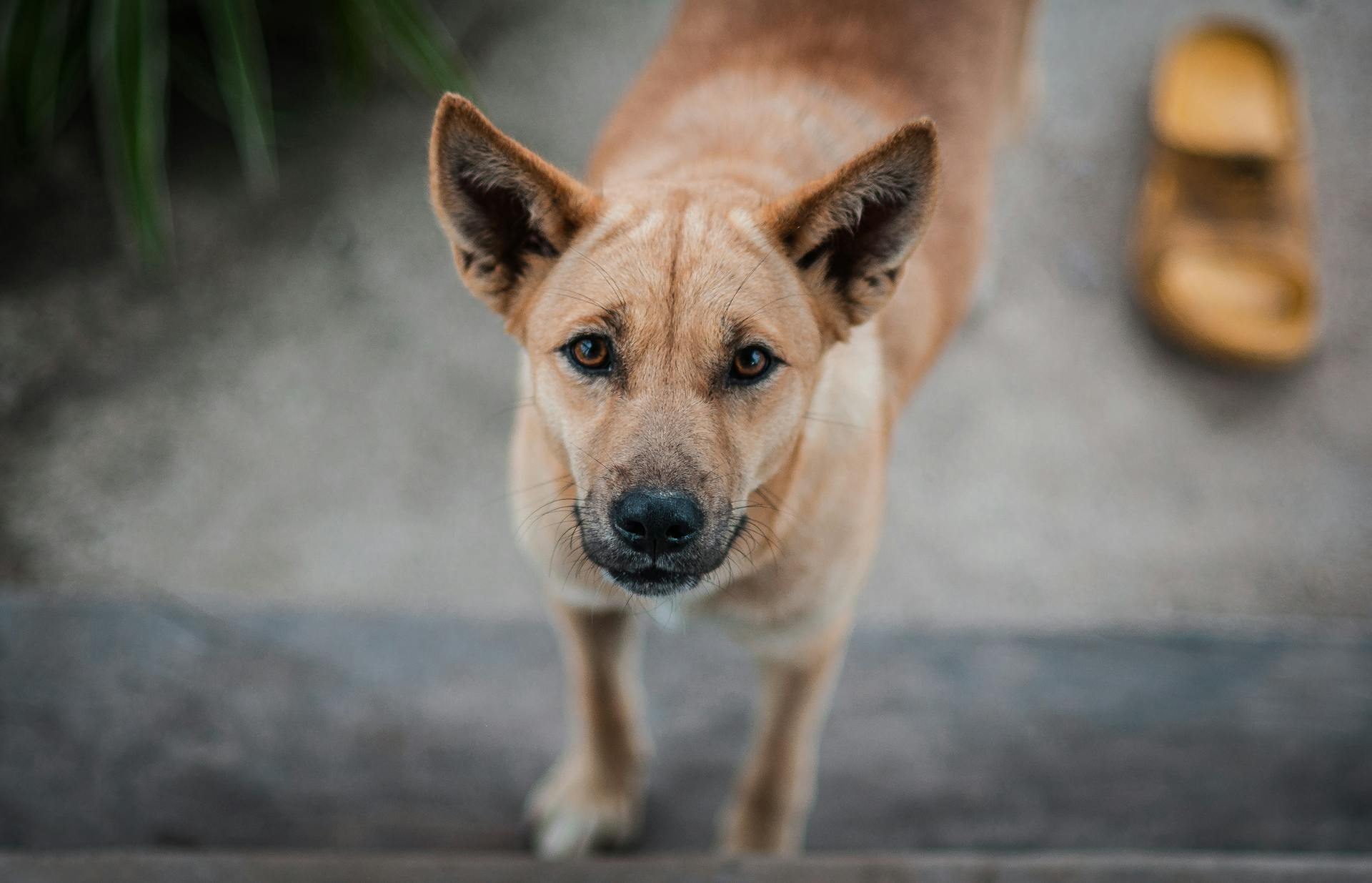
As a Boxer owner, it's natural to be concerned about any unusual growths on your dog's body. Lipomas are one of the most common growths found on Boxers, and they're usually benign, fatty tumors that can be easily removed.
Lipomas are typically soft to the touch and can be movable under the skin. They often appear as small, round lumps on the dog's neck, back, or sides.
Some Boxers may also develop sebaceous cysts, which are usually small, painful bumps that can be filled with a thick, cheesy discharge. These cysts can appear anywhere on the dog's body, but are most commonly found on the head, neck, or near the base of the tail.
Sebaceous cysts can be painful for your dog, but they're generally not a cause for concern and can be easily treated with antibiotics or surgery.
You might enjoy: Do French Bulldogs Overheat Easily
Causes and Symptoms
Growths on boxer dogs can appear anywhere on the body or in the mouth, and they can range in size from very small to very large.
Abnormal growths can be a sign of a tumor, growth, or cyst, and warning signs include an abnormal skin lump or a bump, a swollen area, an oral growth, enlarged lymph nodes, and lameness or swelling affecting a bone.
These symptoms can be uncomfortable and even painful for your dog, so it's essential to be aware of them and consult a veterinarian if you notice anything unusual.
Here are some possible causes of growths on boxer dogs:
- Environmental factors or illnesses may contribute to skin problems.
- Genetics can also play a major role in the development of tumors, growths, and cysts.
Causes of Growths
Growing a growth on your furry friend can be alarming, but understanding the possible causes can help put your mind at ease. Genetics can play a major role in the development of other types of tumors, growths, and cysts.
Some skin problems in dogs are thought to be caused by environmental factors or illnesses. This is why it's essential to keep an eye on your dog's health and behavior.
In some cases, a growth can be a benign cyst that's not cancerous. However, it's always best to consult with a veterinarian to determine the cause and type of growth.
Symptoms of Growths

Symptoms of Growths can be quite alarming. Abnormal skin lumps or bumps can appear anywhere on the body, ranging in size from very small to very large.
A swollen area, especially within the body, is a common warning sign. This can be a cause for concern, especially if it's persistent or growing in size.
Oral growths are another type of abnormal growth that can occur in the mouth. If you notice any unusual lumps or bumps in your dog's mouth, it's essential to have them checked by a veterinarian.
Enlarged lymph nodes can be a sign of underlying health issues. If you notice any swelling in your dog's neck or armpits, it's crucial to have them examined by a veterinarian.
Lameness or swelling affecting a bone is a symptom that requires immediate attention. If your dog is showing signs of pain or discomfort in a particular area, it's essential to seek veterinary care as soon as possible.
Here are some common symptoms of growths in dogs:
- Abnormal skin lump or bump
- Swollen area (particularly within the body)
- Oral growth
- Enlarged lymph nodes
- Lameness or swelling affecting a bone
Diagnosis and Treatment
A physical exam by your vet is the first step in diagnosing a growth on your Boxer dog. They'll note the location of the lesion, how long it's been there, and any changes that have occurred since you first noticed it.
Taking photographs can be helpful for your veterinarian to make a diagnosis. This can include taking an impression of the surface of the growth or withdrawing a small sample of cells in the exam room.
Most veterinarians evaluate impression smears or fine needle aspirates by staining the slide and examining it under a microscope in the veterinary office. If a fine needle aspirate is not effective, a biopsy may be recommended.
A biopsy is often performed with the dog under general anesthesia or sedation, but local anesthesia may be used instead depending on the size and location of the mass. The vet may use a special large needle or cut into the mass surgically.
For your interest: Vets Dog Treats
Here are some options for treatment of a growth on your Boxer dog:
- Monitoring for changes
- Removal by freezing or laser treatments
- Surgical removal of the lump with or without also removing some normal tissue
- Chemotherapy
- Radiation
Your vet will determine the best course of treatment based on the type of growth and its location. They may recommend additional diagnostics, such as lab tests, radiographs, ultrasound, or CT scans, to determine the extent of the growth.
Types of Growths
Boxer dogs can develop a variety of growths, some of which are benign and others that are malignant. Some common types of growths on boxer dogs include lipomas, which are benign fatty tumors that can appear anywhere on the body, but are more common in older dogs and those who are overweight.
Lipomas are typically firm to the touch and can be moved around under the skin, but they can become quite large and may bother your dog if they're located in an area that interferes with motion. They can also transform into cancerous growths called liposarcomas, so it's essential to monitor them over time.
Mast cell tumors, on the other hand, are the most common malignant tumor seen in dogs and can appear anywhere on the body. They often affect older dogs, but can occur in dogs of any age, and are more likely to spread if they're large or rapidly growing. Mast cell tumors can look like many other lumps and bumps, so it's crucial to have your veterinarian check them out.
Histiocytomas are benign skin growths that usually occur in dogs less than 2 years of age, but can also appear in older dogs. They're typically found on the front half of a dog's body and are pink and fleshy, but may get bigger and seem more irritated before improving. They usually regress spontaneously over time without treatment.
Here are some common types of growths found on boxer dogs, along with their characteristics:
It's essential to have any growths on your boxer dog checked out by a veterinarian to determine the best course of action. They can help you monitor the growth and recommend treatment if necessary.
Specific Growths
Mast cell tumors are the most common skin cancer in dogs, often found in dogs older than 8 years of age.
These tumors can occur in specific breeds, including boxers, Boston terriers, Labrador retrievers, beagles, and schnauzers. Some mast cell tumors can appear as small, freely movable tumors of the skin.
On a similar theme: Bichon Frise Skin Problems
Papilloma
Papilloma is a contagious growth that can appear in and around your dog's mouth, especially in young dogs.
They can also appear around the eyes or on other areas of the body in older dogs.
Papillomas are caused by a virus that can be spread through direct contact with an infected dog or contaminated items.
The growths are small, fleshy, and round with a cauliflower-like texture to the surface.
Many papillomas will dry up and fall off within a few months as your dog's immune system matures.
Severe cases can make eating or swallowing difficult and may require surgical removal.
Fibrosarcomas
Fibrosarcomas are a type of malignant tumor that can affect dogs. They are common, fast-growing, and often appear on the trunk and legs. Most fibrosarcomas are lumpy in appearance, while others may be firm and fleshy.
Fibrosarcomas can invade underlying muscles, but they rarely spread to other areas of the body. Treatment typically involves surgical removal, although complete removal may not be possible, and regrowth is common.
In some cases, radiation and chemotherapy may also be used to treat fibrosarcomas. It's essential to work closely with a veterinarian to determine the best course of treatment for your dog.
If your dog has a fibrosarcoma, it's crucial to monitor its size and shape regularly. Keep an eye out for any changes, such as an increase in size or a change in texture.
Squamous Cell Carcinomas
Squamous Cell Carcinomas are a type of cancer that can affect dogs, typically found in areas with less pigment, sparse hair, or exposed to the sun.
They can appear as firm, raised, irregular, and ulcerated areas, often solitary but sometimes multiple in areas of prolonged sun exposure.
Squamous Cell Carcinomas can be found in two places on a dog: on the surface of the skin or under a nail.
Treatment for Squamous Cell Carcinomas involves complete surgical removal of the tumor along with some normal tissue.
These growths invade surrounding tissues, with some growing more rapidly than others.
Early detection is key to successful treatment, as Squamous Cell Carcinomas are relatively slow growing.
Dogs tend to be diagnosed with SCC when they are between 8 and 10 years old.
If you suspect your dog has a Squamous Cell Carcinoma, it's essential to make an appointment with your veterinarian for a proper evaluation.
Here are some common characteristics of Squamous Cell Carcinomas:
Prevention and Prognosis
Prevention is key when it comes to growths on boxer dogs. Maintaining a healthy diet and active lifestyle for your dog can help prevent some growths from forming.
Spaying your dog before her first heat cycle can virtually eliminate the chances of mammary tumors. This is a crucial step in preventing one of the most common types of growths in female dogs.
Regular veterinary check-ups are essential for monitoring your dog's health and catching any potential growths early. Adhere to a regular grooming schedule and take note of any new lumps or bumps on your dog's skin.
By staying on top of your dog's health, you can help prevent growths from forming and ensure your furry friend lives a long and healthy life.
Tumor Prevention
Preventing tumors, growths, and cysts is a vital part of keeping your furry friend healthy. Maintaining a healthy diet and active lifestyle for your dog is crucial.
Adhering to a regular grooming schedule can help you notice any new lumps or bumps on your dog's skin. A photo and written record can aid in tracking growth and detecting rapid change.
Spaying your dog before her first heat cycle can significantly reduce the chances of developing mammary tumors. This is a vital consideration for many pet owners.
If you notice any rapid changes in a lump or bump, it's essential to speak with a veterinarian right away. Early detection can make a significant difference in treatment and prognosis.
Here are some key factors to consider for tumor prevention:
Prognosis for Growths

The prognosis for growths in dogs can be a bit of a mixed bag, but it's generally good if you catch them early. The smaller the growth, the easier it is to remove and often results in no additional treatments.
If the growth is benign, it's unlikely to spread to other areas of the body, which is a big plus. Benign tumors are not likely to spread to other areas on the body.
However, if the growth is a mast cell tumor, it's a different story. Mast cell tumors are the most common malignant tumor seen in dogs and can occur in dogs of any age. They often affect older dogs but can occur in dogs of any age—even puppies.
The key to a good prognosis is early detection and treatment. If you notice any unusual growths on your dog, it's essential to get them checked out by a veterinarian as soon as possible. Your vet will need to examine a sample of cells from the growth under a microscope to confirm a diagnosis.
Worth a look: Dog Body Language with Other Dogs
Frequently Asked Questions
What does a mast cell tumor look like on a Boxer?
A mast cell tumor on a Boxer typically appears as a single lump, which can resemble a small hair-covered bump or a larger red ulcerated lesion, making it difficult to diagnose without a veterinary examination. If you suspect your Boxer has a mast cell tumor, consult a veterinarian for proper diagnosis and treatment.
What does a cancerous skin growth look like on a dog?
A cancerous skin growth on a dog typically appears as a firm, raised, and often ulcerated mass that resembles a wart, and can grow into large, irregular shapes. If you suspect your dog has a skin growth, it's essential to consult a veterinarian for proper diagnosis and treatment.
At what age do Boxers get mast cell tumors?
Boxers can develop mast cell tumors as early as 4 months old, but the average age of diagnosis is around 8 years old. If you're a Boxer owner, learn more about mast cell tumors and their symptoms to stay informed and proactive about your dog's health.
Are Boxers prone to tumors?
Yes, Boxers are prone to certain types of tumors, particularly brain tumors and mast cell tumors, which are more common in this breed than any other purebred dog breed. Boxers are also at higher risk of developing brain cancer after the age of 8.
What does a sarcoma lump look like on a dog?
A sarcoma lump on a dog typically appears as a firm, single lump or bump on or under the skin, which may be nodular and sometimes ulcerate, bleed, or become infected. If you suspect your dog has a sarcoma lump, consult a veterinarian for proper diagnosis and treatment.
Sources
- https://www.petmd.com/dog/symptoms/lumps-bumps-and-cysts-dogs
- https://www.thesprucepets.com/tumors-growths-and-cysts-on-dogs-4116142
- https://www.mspca.org/angell_services/benign-skin-masses-of-dogs/
- https://www.webmd.com/pets/dogs/dog-lumps-bumps-skin
- https://www.diamondpet.com/blog/health/sensitive-skin/the-12-lumps-and-bumps-of-canine-skin/
Featured Images: pexels.com


